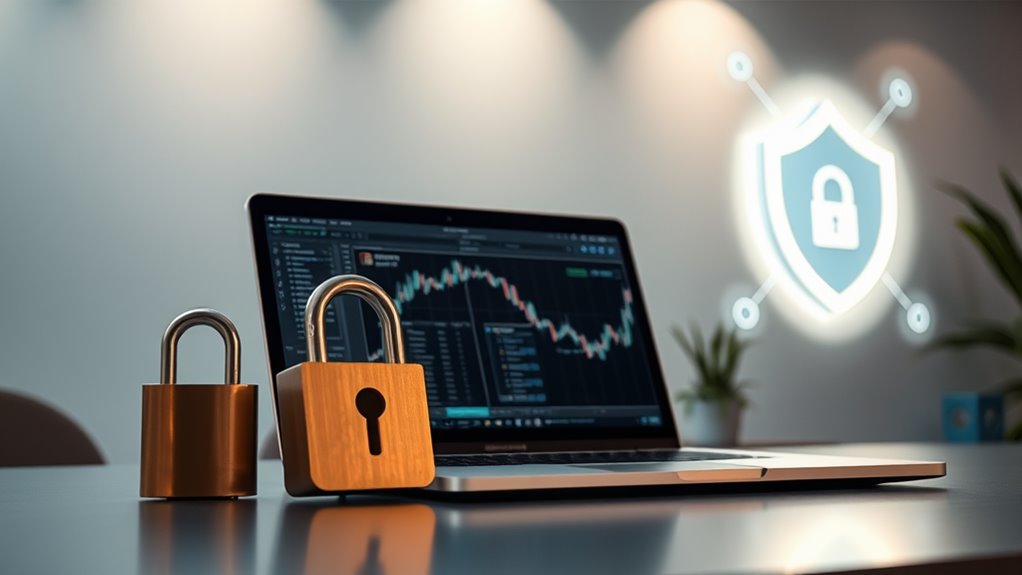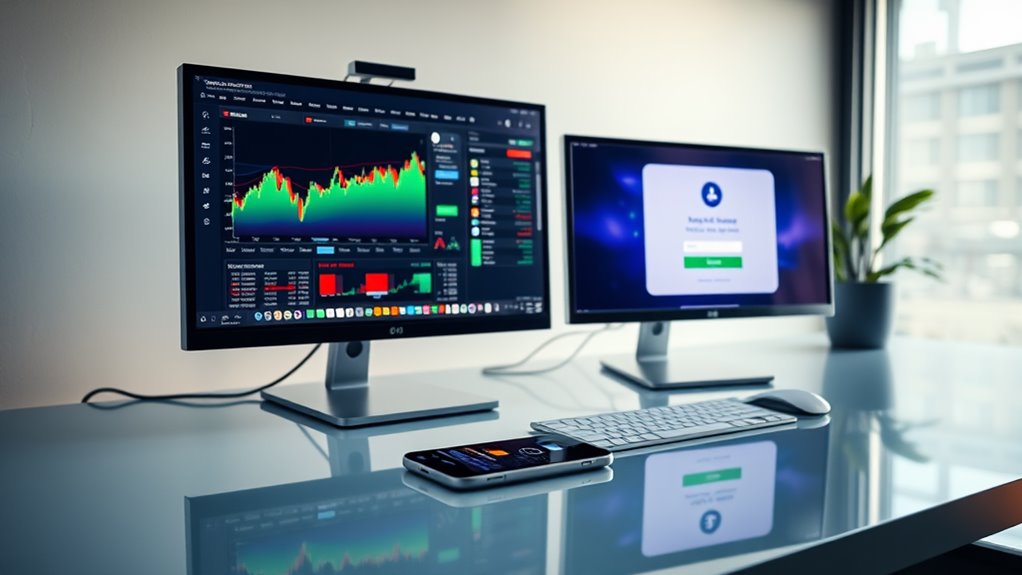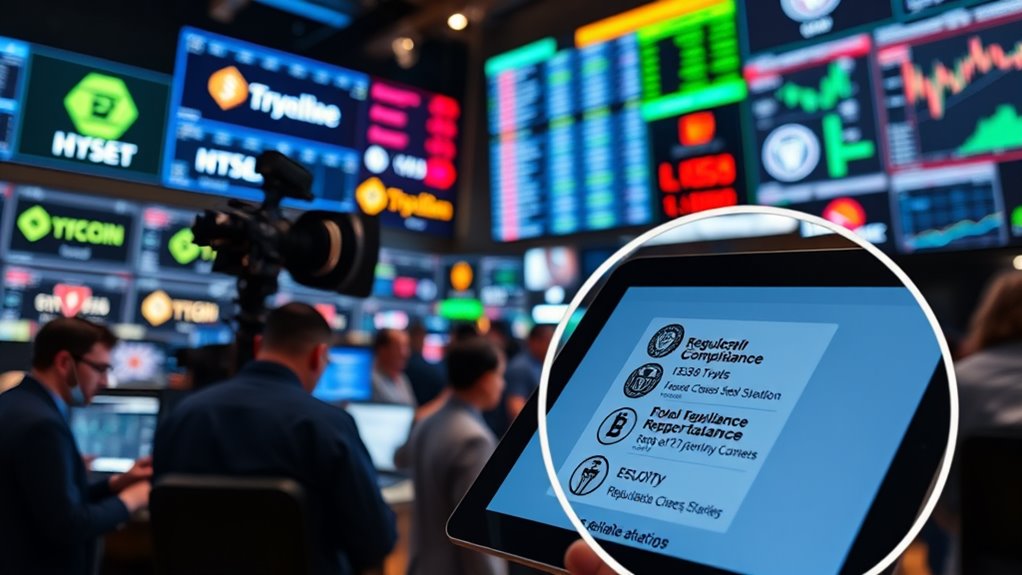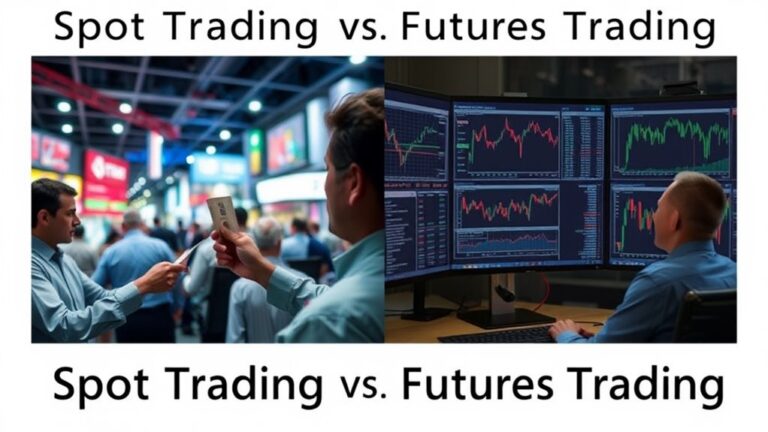
Choosing the Right Crypto Exchange: Top Criteria for a Secure Trading Experience
When selecting a crypto exchange, prioritize platforms with robust security measures like two-factor authentication and cold storage. Compare fee structures, checking for hidden costs that affect profitability. Confirm the exchange offers your preferred cryptocurrencies and provides intuitive user interfaces for efficient trading. Advanced features like API access support sophisticated strategies, while regulatory compliance indicates legitimacy. A reputable exchange also offers transparent policies and insurance options. The following criteria will help traders make informed decisions for secure trading experiences.
Key Takeaways
- Verify exchange security measures, including endpoint protection, cold storage, multi-signature wallets, and insurance options for user funds.
- Check regulatory compliance and registration with financial authorities like FinCEN, SEC, or NYDFS to ensure legitimacy.
- Compare fee structures and identify hidden costs such as spreads, network fees, and withdrawal limits that affect profitability.
- Evaluate cryptocurrency selection, focusing on liquidity, stablecoin options, and availability of both major coins and promising altcoins.
- Assess user experience quality, including interface design, platform stability, and availability of advanced trading tools for your strategy needs.
Security Infrastructure and Protective Measures

When selecting a cryptocurrency exchange, security infrastructure should be a top priority for investors concerned about protecting their digital assets. Exchanges that implement robust endpoint security tools, such as SentinelOne and CrowdStrike, offer better protection against threats targeting user devices.
Look for platforms utilizing air-gapped systems and Hardware Security Modules (HSMs) to safeguard critical keys and data.
The most secure exchanges employ multiple protective layers including cold storage for most assets, multi-signature wallets requiring several approvals for transactions, and mandatory two-factor authentication.
Real-time monitoring systems that track on-chain activity can detect suspicious behavior quickly, while insurance coverage provides an additional safety net for user funds. Additionally, reputable exchanges often adhere to Know Your Customer (KYC) processes to ensure compliance and enhance user protection.
These security measures work together to create a thorough defense against potential breaches and unauthorized access attempts.
Fee Structure and Trading Costs Analysis

The fee structure of cryptocurrency exchanges greatly impacts overall trading profitability, with each platform offering distinctly different transaction costs ranging from maker-taker fees to deposit-withdrawal charges.
Many exchanges implement hidden costs beyond their advertised rates, including unfavorable exchange rates, network fees, and currency conversion surcharges that can substantially affect returns.
Traders can implement several fee reduction strategies, such as maintaining higher trading volumes, holding native exchange tokens like BNB or KCS, and selecting platforms offering promotional fee discounts or rebate programs. Understanding these trading fees is crucial as they can erode investment returns over time.
Transaction Fee Comparison
Most crypto exchanges implement complex fee structures that notably impact trading profitability.
When comparing transaction costs across platforms, several patterns emerge that can guide selection decisions.
- Maker-taker model is standard, with maker fees (0.01-0.1%) typically lower than taker fees (0.02-0.6%), rewarding liquidity providers.
- Volume-based discounts apply on most exchanges, with high-volume traders receiving considerably reduced fees.
- Platform differences are substantial – Binance (0.1%) and MEXC (0% maker) offer lower base rates than Coinbase (0.4-0.6%).
- Fiat-to-crypto conversions generally cost more than crypto-to-crypto trades across all exchanges.
- Fee optimization strategies include using limit orders, platform-specific tokens (like BNB), and subscription services (Coinbase One).
Understanding these fee structures helps traders minimize costs while maximizing returns on their cryptocurrency investments. Additionally, traders should consider the importance of selecting a secure exchange with strong security measures to protect their assets during transactions.
Hidden Costs Revealed
Beyond the advertised transaction fees, crypto exchanges often implement numerous hidden charges that can greatly impact trading profitability. These costs include execution fees, network fees, conversion fees, and inactivity penalties that can erode returns, particularly for frequent traders. Understanding the liquidity and order book depth of the exchanges can also provide insight into potential hidden costs.
| Hidden Cost Type | Impact on Traders |
|---|---|
| Spreads | Can vary by 0.1-3% between exchanges |
| Execution Fees | Average 80 basis points on $25,000 trades |
| Funding Rates | Apply to leveraged positions, compounding costs |
| Withdrawal Limits | Restrict liquidity and may incur additional fees |
| Network Fees | Fluctuate with blockchain congestion |
Understanding these hidden costs is vital when selecting an exchange. Trading volume, market conditions, and regulatory compliance all influence fee structures. As the industry evolves, zero-fee models and dynamic pricing are emerging, though these often conceal costs elsewhere in the trading experience.
Fee Reduction Strategies
Understanding how to navigate the complex fee structures of cryptocurrency exchanges can greatly impact a trader’s bottom line. Implementing strategic approaches can notably minimize costs while maximizing trading efficiency.
- Consolidate trades into fewer, larger transactions to reduce the number of times fees are incurred.
- Place limit orders instead of market orders to qualify for lower maker fees rather than higher taker fees.
- Hold exchange native tokens like Binance Coin (BNB) to access fee discounts offered by many platforms.
- Increase trading volume to qualify for tiered fee discounts that reward high-volume traders.
- Consider trading during off-peak hours when network congestion is lower, resulting in reduced gas fees.
Additionally, understanding the importance of user-friendly interfaces can help traders navigate exchanges more efficiently and reduce the likelihood of costly mistakes.
Regular review of these strategies guarantees traders can adapt to changing fee structures and maintain cost-effective trading practices.
Cryptocurrency Selection and Token Support

The breadth of cryptocurrency offerings, from major coins like Bitcoin and Ethereum to thousands of altcoins, varies greatly between exchanges and directly impacts trading possibilities.
Exchanges with frequent new token listings provide traders access to emerging cryptocurrencies, though these often come with higher volatility and risk profiles.
Stablecoin trading pairs, available on platforms like Kraken and Crypto.com, offer traders a way to maintain dollar-equivalent positions without converting back to fiat currency, reducing potential fees and simplifying portfolio management. Additionally, understanding the different types of altcoins can help traders make informed decisions about potential investments and their associated risks.
Major vs. Altcoin Offerings
While selecting a crypto exchange, investors must consider whether they need access to major cryptocurrencies, altcoins, or both. Major cryptocurrencies like Bitcoin and Ethereum offer higher liquidity and market stability, while altcoins provide diversification opportunities with potentially higher growth, albeit with increased risk.
Exchange platforms vary markedly in their token offerings:
- Major exchanges typically feature robust security measures and regulatory compliance.
- Exchanges like Binance and Bitmart offer hundreds to thousands of cryptocurrencies.
- Altcoin-focused platforms often provide competitive fees to attract diverse traders.
- Advanced trading features such as futures and margin trading are more common on altcoin exchanges.
- Security protocols including 2FA, cold storage, and withdrawal whitelisting are essential regardless of exchange type.
The ideal platform ultimately depends on individual trading goals, risk tolerance, and experience level. Additionally, platforms like Binance Academy provide valuable educational resources for beginners to enhance their trading knowledge.
New Token Listing Frequency
As cryptocurrency markets evolve, the frequency of new token listings serves as a crucial barometer for exchange quality and market health. Token listing activity typically fluctuates with market conditions, with increased frequency during bull markets and reduced listings during bearish periods.
Major centralized exchanges like Binance lead in new token introduction volume, while decentralized exchanges offer alternative pathways without formal approval processes. Exchanges select tokens based on market demand, technological viability, compliance requirements, community interest, and tokenomics structure.
Investors can monitor new listings through exchange notifications, crypto news sites, community forums, dedicated alert services, and social media announcements. The integration of Decentralized Finance (DeFi) into exchanges may also influence the types of tokens available for trading.
When evaluating exchanges, consider how their listing frequency aligns with your investment strategy, as platforms with regular, quality additions often provide more diverse trading opportunities and reflect stronger market positioning.
Stablecoin Trading Pairs
Stablecoin trading pairs represent a fundamental component of modern cryptocurrency exchange platforms, offering traders essential tools for portfolio management and risk mitigation.
When selecting an exchange, users should evaluate the diversity and liquidity of available stablecoin options.
- Major exchanges support popular stablecoins like USDT and USDC, providing varied trading options.
- Stablecoins consistently demonstrate higher trading volumes than other cryptocurrencies, ensuring smoother transactions.
- These assets allow traders to effectively hedge against market volatility without converting to fiat currencies.
- Both centralized and decentralized platforms support stablecoin trading, accommodating different preferences.
- Stablecoins facilitate quick, cost-effective cross-border transactions, improving global liquidity.
The availability of multiple stablecoin trading pairs enhances overall trading flexibility while maintaining value stability during market fluctuations, making them an essential consideration when choosing a cryptocurrency exchange. Moreover, as regulations evolve to focus on consumer protection, the role of stablecoins in the crypto ecosystem will likely become even more pivotal.
User Interface and Trading Experience

What separates an excellent crypto exchange from a mediocre one? Often, it’s the quality of the user interface and overall trading experience. A well-designed platform features intuitive navigation with logical pathways and clear categorization that helps users locate features efficiently.
The best exchanges prioritize user-centered design elements, including interface simplicity, customization options, and guided onboarding processes for newcomers. Accessibility features like keyboard navigation, screen reader compatibility, and adequate color contrast guarantee all users can trade effectively.
Exceptional platforms blend simplicity with customization while ensuring inclusive accessibility for traders of all experience levels.
Real-time market data, cross-device compatibility, and responsive layouts further enhance the trading experience. The platform should offer educational resources and multi-language support to accommodate global users. Additionally, users should expect a smooth sign-up and verification process, which is crucial for ensuring account security and compliance.
When evaluating exchanges, look for those that balance sophisticated trading tools with straightforward usability, making cryptocurrency trading accessible to both beginners and experienced traders.
Advanced Trading Tools and Features

Beyond the basic interface, serious cryptocurrency traders need specialized tools to execute complex market strategies. When evaluating exchanges, look for platforms that offer sophisticated functionality to support advanced trading approaches:
- API capabilities with REST, WebSocket, and FIX support for high-frequency trading and bot integration
- Advanced order types such as iceberg and TWAP orders that enhance strategy flexibility
- Leveraged trading options allowing position amplification with borrowed capital
- Futures and derivatives markets for implementing complex trading strategies
- Portfolio management features including unified views across exchanges and risk management tools
The best exchanges also provide deep liquidity, high-speed execution, and extensive market visibility.
For algorithmic traders, factors like API rate limits, programming language support, and low-latency connections become critical selection criteria when choosing where to trade.
Regulatory Compliance and Exchange Reputation

Maneuvering the complex regulatory landscape of cryptocurrency exchanges requires careful attention to compliance standards and reputation indicators. Traders should verify that exchanges are registered with appropriate regulatory bodies like FinCEN, SEC, or NYDFS, depending on jurisdiction requirements.
A reputable exchange demonstrates compliance through transparent policies, regular third-party audits, and robust security measures including cold storage solutions and two-factor authentication.
Community feedback and regulatory history provide valuable insights into an exchange’s reliability. Before trading, users should check if the platform implements thorough AML and KYC programs.
The most trustworthy exchanges maintain clear communication channels, provide educational resources about compliance practices, and employ dedicated compliance officers who stay current with evolving regulations.
Insurance options for user funds further indicate a commitment to security and regulatory adherence.
Frequently Asked Questions
How Do I Recover My Account if I Lose My Authentication Credentials?
One can recover lost authentication credentials through seed phrases, backup files, or exchange customer support. Utilizing hardware wallets, specialized recovery software, or professional services may also restore access to compromised cryptocurrency accounts.
Do Exchanges Offer Insurance Against Hacks or Asset Theft?
Many exchanges offer insurance coverage against hacks and theft, but policies vary considerably. Custodial insurance is most common, protecting stored assets. Not all exchanges provide this protection, making policy verification essential for investors.
Can I Transfer Assets Directly Between Different Cryptocurrency Exchanges?
Yes, users can transfer assets directly between different cryptocurrency exchanges. This process requires verifying network compatibility, ensuring correct wallet addresses, and understanding transaction fees and times associated with the chosen network.
How Long Do Cryptocurrency Deposits and Withdrawals Typically Take?
Like maneuvering through a digital labyrinth, cryptocurrency deposits and withdrawals typically take anywhere from minutes to 24 hours, depending on blockchain congestion, exchange policies, and required confirmation blocks for transaction security.
What Tax Reporting Tools Do Exchanges Provide for Cryptocurrency Transactions?
Cryptocurrency exchanges typically provide limited tax reporting tools, offering primarily CSV exports and API connections that allow integration with specialized tax software like Koinly or CoinLedger for generating necessary tax forms and calculations.
Conclusion
Choosing a cryptocurrency exchange is a journey through a forest of options, each with varying security levels, fee structures, and available tokens. By prioritizing robust security, reasonable fees, diverse crypto offerings, user-friendly interfaces, advanced trading tools, and regulatory compliance, traders can establish a secure foundation for their cryptocurrency activities. This careful consideration guarantees a trading experience that balances protection, functionality, and cost-effectiveness.












